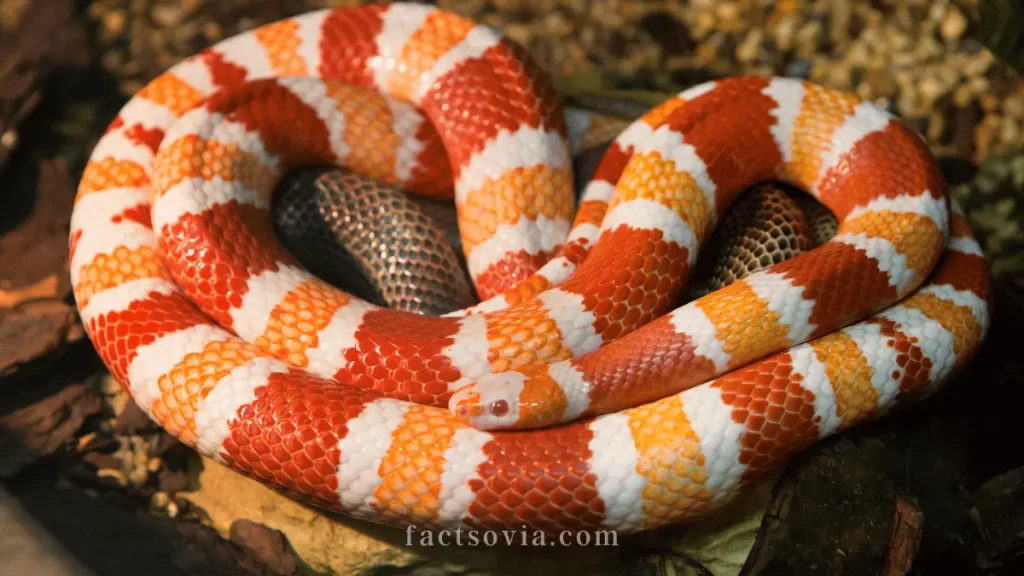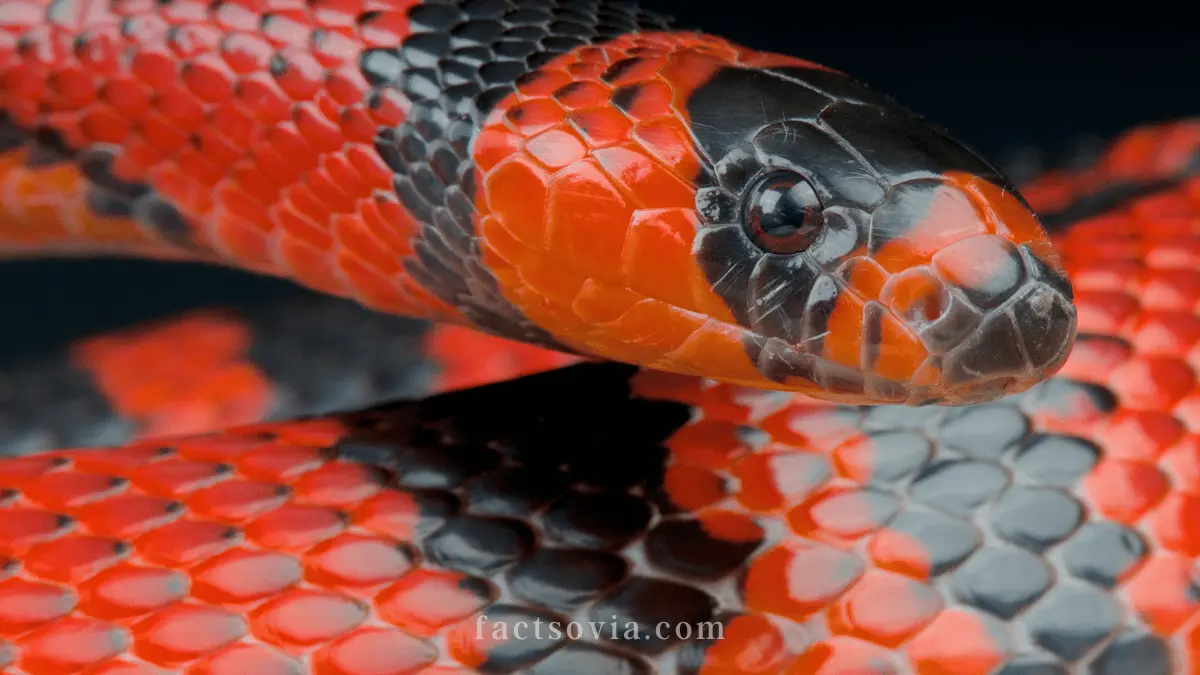We use affiliate links to run our site. When you buy through links on our site, we may earn an affiliate commission, without any added cost to you. Learn more
With their brilliant tricolor banding in hues of red, black, and yellow, Honduran milk snakes are some of the most vibrantly patterned snakes in Central America.
But there’s much more to their stunning looks. Growing up to 6 feet long, these nonvenomous serpents have a fascinating set of behaviors and adaptations that allow them to thrive in the humid tropical forests they inhabit.
From their talent for subduing prey to their incredible 20+ year lifespans, Honduran milk snakes showcase a myriad of special traits. Read on to uncover 10 captivating facts about one of nature’s most colorful reptiles!
| Scientific Name | Lampropeltis triangulum hondurensis |
| Common Name | Honduran Milksnake |
| Description | Narrow-bodied snake with black and red bands |
| Size | Approximately 150 cm (5 ft.) |
| Weight | Average 1270 g (2.77 lbs.) |
| Diet | Small mammals, eggs, and other reptiles |
| Incubation | 10 weeks |
| Clutch Size | 3-24 eggs |
| Sexual Maturity | 3-12 years |
| Life Span | Up to 20 years |
| Range | Nicaragua, Northeastern Costa Rica, Caribbean slope of Honduras |
| Habitat | Leaf litter in rainforests |
| Ecology and Conservation | Plays a role in regional food chains as both predator and prey. Helps control rodent populations, especially near human settlements. |
10 Interesting Facts About Honduran Milksnakes
1. They’re a Subspecies of Kingsnake
Honduran milk snakes, scientific name Lampropeltis triangulum hondurensis, are a subspecies of the kingsnake genus Lampropeltis. There are over 30 recognized subspecies of kingsnakes found throughout the Americas, with each subspecies possessing distinctive colors and patterns.
Honduran milk snakes are one of the larger and more vibrantly colored subspecies. They share the docile temperament and ophiophagous (snake-eating) habits common to all kingsnakes.
2. Found in Tropical Central America
These snakes are native to the tropical forests and jungles of Central America. Their range extends along the Caribbean coastal regions of northern Honduras, Nicaragua, and northeastern Costa Rica.
They occupy areas below 3,300 feet in elevation and are found in a variety of humid forest habitats including tropical dry forests, pine-oak forests, and cloud forests. Logging and deforestation threaten some of their natural habitat.
3. They Can Grow Up to 6 feet in Length
Honduran milk snakes are one of the larger milk snake species, capable of reaching total lengths of 4 to 6 feet when full-grown. Their average size is around 3 to 5 feet. Females tend to be larger than males.
The longest recorded length for a Honduran milk snake in captivity is just over 7 feet. They have a thick, muscular body and can weigh from 2 to 5 pounds when fully grown.
Do Snakes Have Bones? The Mysteries of Snake Anatomy
4. They Possess Distinctive Tricolored Banding
Bright red, black, and yellow banding in stacked tricolor patterns gives Honduran milk snakes their most recognizable feature. The red bands are bordered in black and the colors contrast sharply against the milk snake’s paler grey or tan background color.
The striking banding serves as a warning to potential predators by mimicking the color patterns of deadly coral snakes. This form of mimicry is called Batesian mimicry.
5. Docile Nature
Despite their size and intimidating appearance, Honduran milk snakes have a very calm and docile personality when handled. They rarely bite and make great pets due to their tolerance of regular handling and captive environments.
Proper care is still needed, however, and they should not be handled for too long due to their sensitive skin.
6. Opportunistic Feeders
In the wild, Honduran milk snakes will eat any prey they can overpower with their strong bodies and constricting abilities.
Rodents and lizards make up a large part of their diet. But they are also opportunistic ophiophagous snakes, meaning they will eat other snakes, even venomous species.
Bird eggs, small mammals, and amphibians may also be taken.

7. Muscular Constrictors
To subdue their prey, Honduran milk snakes rely on constriction. They are immensely strong for their size and wrap their muscular bodies around victims, squeezing tightly until prey dies from suffocation. The pressure of their coil can easily kill large rodents, other snakes, and even small mammals. They are not venomous snakes.
8. They Are Quite Sensitive to Temperature Changes
One key aspect of properly caring for Honduran milk snakes in captivity is maintaining the right temperature range. They thrive at temperatures between 75°F to 85°F and require a basking area around 90°F.
Cooler temperatures can disrupt their digestion and immune system. Providing proper heating with a thermal gradient is important.
9. Long Lifespans in Captivity
With proper care, Honduran milk snakes can live over 20 years in captivity. Their average lifespan is between 15 to 25 years when kept as pets.
Ensuring proper housing, temperatures, hydration, and nutrition are vital to maximizing their longevity. Their long lifespans and relatively small size make them lifelong pets.
10. Easy to Care For
Honduran milk snakes are regarded as one of the easiest snake species to care for in captivity. Their small space requirements, simple nutritional needs, calm demeanor, low humidity requirements, and disease resistance make them ideal pet snakes, even for beginners. Their appeal also comes from their beautiful appearance and longevity as pets.
Poison or Venom: What is the difference
Final Thoughts:
Honduran milk snakes continue to entice reptile enthusiasts with their vivid appearance and impressive abilities. Their wide range of sizes, diverse feeding behavior, and terrestrial lifestyles showcase the remarkable adaptability of these snakes.
We hope these 10 facts have shed new light on Honduran milk snakes for you. Be sure to explore the rest of our site for more captivating information about reptiles from around the world.
If you’re interested in getting one of these incredible snakes as a pet, consult an exotic pet specialist to learn how to properly care for them. With their beautiful looks, docile nature, and long lifespan, Honduran milk snakes can make fantastic lifelong animal companions.
Amazon and the Amazon logo are trademarks of Amazon.com, Inc, or its affiliates.
